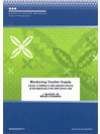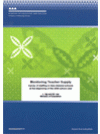The 2009 Monitoring Teacher Supply report provides the Ministry with a snapshot of the number of entitlement staffing vacancies and re-advertised vacancies in schools at the start of Term 1, how these vacancies are being covered and, in the case of secondary schools, in what subject areas pressure points are occurring.
Key Results
The Research Division, Ministry of Education administers the Survey of Staffing annually to provide the Ministry with a snapshot of the number of entitlement staffing vacancies and re-advertised vacancies in schools at the start of Term 1. In 2009, the survey was completed by 95 percent of all state and state-integrated schools.
Results from this year’s survey showed that the overall staffing vacancies in New Zealand schools at the beginning of the school year, as a proportion of all entitlement positions, has dropped slightly from the previous four years (from 0.9% to 0.8% in 2009). The drop was mainly due to the decrease in the proportion of vacancies in secondary schools, since vacancies in primary schools have remained the same from the previous year (0.7%), but the proportion of vacancies dropped from 1.1 percent in 2008 to 0.8 percent in secondary schools. The subject areas with the highest number of vacancies in secondary schools were English and Technology.
Re-advertised positions in schools are considered to be an indication of ‘hard-to-staff’ positions. This year, the proportion of re-advertised positions was lower than the past two years, again while the proportion of re-advertised positions has remained the same for primary schools, the proportion at secondary schools has decreased. Forty-three percent of vacancies have been re-advertised. Overall, similar to previous years, the proportions of re-advertised positions were greatest in schools in rural localities, in schools with a higher proportion of Māori students on their roll, and in low decile schools (deciles 1-3).
The survey also examined other sources of teacher supply for New Zealand schools, including the recruitment of first year (beginning) teachers, and teachers from overseas. In 2009, there was a drop in the proportion of first year beginning teachers, but the proportion of overseas-trained teachers who began teaching in New Zealand in 2008 or 2009 remained fairly consistent


